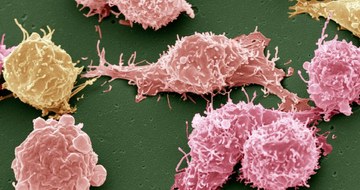Abstract
Purpose
Pirtobrutinib is a highly selective, noncovalent (reversible) Bruton tyrosine kinase inhibitor (BTKi). We report the safety and efficacy of pirtobrutinib in patients with covalent Bruton tyrosine kinase inhibitor (cBTKi) pretreated mantle-cell lymphoma (MCL), a population with poor prognosis.
Methods
Patients with cBTKi pretreated relapsed/refractory (R/R) MCL received pirtobrutinib monotherapy in a multicenter phase I/II trial (BRUIN; ClinicalTrials.gov identifier: NCT03740529). Efficacy was assessed in the first 90 consecutively enrolled patients who met criteria for inclusion in the primary efficacy cohort. The primary end point was overall response rate (ORR). Secondary end points included duration of response (DOR) and safety.
Results
The median patient age was 70 years (range, 46-87), the median prior lines of therapy was 3 (range, 1-8), 82.2% had discontinued a prior cBTKi because of disease progression, and 77.8% had intermediate- or high-risk simplified MCL International Prognostic Index score. The ORR was 57.8% (95% CI, 46.9 to 68.1), including 20.0% complete responses (n = 18). At a median follow-up of 12 months, the median DOR was 21.6 months (95% CI, 7.5 to not reached). The 6- and 12-month estimated DOR rates were 73.6% and 57.1%, respectively. In the MCL safety cohort (n = 164), the most common treatment-emergent adverse events (TEAEs) were fatigue (29.9%), diarrhea (21.3%), and dyspnea (16.5%). Grade ≥3 TEAEs of hemorrhage (3.7%) and atrial fibrillation/flutter (1.2%) were less common. Only 3% of patients discontinued pirtobrutinib because of a treatment-related adverse event.
Conclusion
Pirtobrutinib is a first-in-class novel noncovalent (reversible) BTKi and the first BTKi of any kind to demonstrate durable efficacy after prior cBTKi therapy in heavily pretreated R/R MCL. Pirtobrutinib was well tolerated with low rates of treatment discontinuation because of toxicity.
Introduction
Mantle-cell lymphoma (MCL) is an aggressive, rare subtype of B-cell non-Hodgkin lymphoma. Covalent Bruton tyrosine kinase inhibitors (cBTKi) have transformed the therapeutic landscape of multiple B-cell malignancies, including relapsed/refractory (R/R) MCL.1,2 However, the efficacy of cBTKi in this setting is limited by drug resistance or intolerance.3-6 After cBTKi therapy, patients with R/R MCL have historically had very poor outcomes with a median overall survival (OS) <10 months.3,5,7-9 Recent availability of CD19-targeted chimeric antigen receptor (CAR) T-cell therapy for R/R MCL has expanded treatment options, but access is limited, not all patients qualify, and treatment is associated with severe toxicities.10 Therefore, there remains a significant unmet medical need for efficacious, broadly accessible, and well-tolerated therapies for patients with MCL after cBTKi treatment.
Resistance mechanisms to cBTKi vary by tumor type. In chronic lymphocytic leukemia, Bruton tyrosine kinase (BTK) mutations have been well described, most commonly at the C481 position.11 These mutations prevent irreversible drug binding and confer cross resistance to all cBTKi. In MCL, BTK mutations are uncommon, and mechanisms of resistance are less well understood but may converge on epigenetic or genetic mechanisms that collectively restore BTK signaling.4,12-14 Neoplastic MCL cells may also become more proliferative over time, leading to increased BTK protein turnover and incomplete target inhibition with cBTKi.15 Although three cBTKi (ibrutinib, acalabrutinib, and zanubrutinib) have been approved for the treatment of R/R MCL, data suggest similar efficacy for each of these agents.16-18 Importantly, no cBTKi has demonstrated efficacy after progression when used sequentially after another cBTKi.Pirtobrutinib, a highly selective, noncovalent (reversible) BTKi, inhibits both wild-type and C481-mutant BTK with equal low nM potency and has favorable oral pharmacology that enables continuous BTK inhibition throughout the once daily dosing interval, regardless of the intrinsic rate of BTK turnover.19 Here, we report the primary efficacy and safety analysis from cBTKi pretreated patients with MCL enrolled in the phase I/II BRUIN trial.
Methods
Patients
Patients with R/R MCL and other B-cell malignancies, including those who were previously treated with a cBTKi, were eligible for treatment with pirtobrutinib monotherapy in the first-in-human open-label, multicenter, phase I/II BRUIN trial.19 Patient allocation by B-cell malignancy is included in the Data Supplement ([Fig S1], online only). The overall trial design and full eligibility criteria have been previously described19 and are detailed in the protocol (Data Supplement). Eligible patients with MCL were enrolled at 37 sites in eight countries.The trial Protocol (online only) was approved by the institutional review boards overseeing each site. The trial was conducted in accordance with the Declaration of Helsinki, Good Clinical Practice guidelines, and local laws. All patients provided written informed consent. This trial is registered with ClinicalTrials.gov (identifier: NCT03740529).
Trial Design and Treatment
Patients with R/R MCL were treated in either the dose escalation or expansion portion of the trial. The phase I portion explored doses ranging from 25 to 300 mg once daily and the phase II portion utilized the recommended phase II dose of 200 mg once daily. Treatment was administered until disease progression, discontinuation because of toxicity, or patient/physician decision to withdraw. Patients with disease progression were permitted to continue pirtobrutinib treatment if clinical benefit was experienced at the investigator's discretion.
Trial Assessments
The safety cohort included all patients with MCL who were administered at least one dose of pirtobrutinib monotherapy as of the data cutoff date. The primary efficacy cohort included the first 90 patients with MCL consecutively enrolled to either the phase I or II who had measurable disease as assessed per investigator, had received a prior cBTKi-containing regimen, and had no known central nervous system involvement. A data cutoff date of January 31, 2022 was selected to ensure that the vast majority (approximately 90%) of responders in the efficacy cohort would be followed for at least 9 months from date of response onset. Efficacy was also separately assessed in 14 enrolled patients with cBTKi-naïve MCL, who were enrolled in earlier versions of the protocol to both phase I and II portions of the study. Positron emission tomography-computed tomography (PET-CT) scans were used as the primary response assessment modality, when available, with the remainder of patients being assessed by CT scans only.The primary end point was overall response rate (ORR) as assessed by an independent review committee (IRC). Secondary end points included IRC-assessed best overall response (BOR), duration of response (DOR), progression-free survival (PFS), OS, and safety. Disease response assessments were performed at 8-week intervals in the first year, 12-week intervals in the second year, and then every 6 months. In the MCL cohort, the ORR was assessed according to Lugano 2014 criteria,20 integrating CT measurements with FDG-PET when available.21 DOR was measured from the start date of the first documented response to the earlier of the documentation of progressive disease or death from any cause. PFS was measured from the first dose of pirtobrutinib to the earlier of the documentation of progressive disease or death from any cause. OS was measured from first dose of pirtobrutinib to the date of death from any cause. Frequency, attribution, and severity of treatment-emergent adverse events (TEAEs) were investigator assessed from the first dose of pirtobrutinib and graded according to the National Cancer Institute Common Terminology Criteria for Adverse Events, version 5.0 (CTCAE v5.0).
Statistical Analysis
All analyses were conducted according to the statistical analysis plan (SAP) as reviewed by global health authorities (Data Supplement). Under the originally proposed SAP, a sample size of 65 patients in the primary efficacy cohort, also called primary analysis set, was estimated to provide approximately 95% power to have the lower boundary of a two-sided 95% exact binomial CI >20%, if the true ORR is 40%. Ruling out a lower limit of 20% for ORR is considered clinically meaningful for patients with MCL who have discontinued prior cBTKi therapy, as ORRs of approximately 20%-30% were reported in clinical studies testing agents given as monotherapy in patients with cBTKi-naïve advanced MCL (temsirolimus, 22%22; bortezomib, 31%23; lenalidomide, 28%24). The sample size for the primary efficacy cohort was subsequently increased to 90 patients following US regulatory feedback.Descriptive statistics were used to present patient disposition, demographics, and disease characteristics, BOR, and safety data. ORR was estimated with an exact two-sided 95% CI. The Kaplan-Meier method was used to analyze DOR, PFS, and OS. Analyses were performed using SAS version 9.4 (SAS Institute Inc, Cary, NC).
Results
Baseline Patient and Disease Characteristics
From March 21, 2019, to January 31, 2022, a total of 164 patients with MCL were enrolled and treated with pirtobrutinib, including 90 cBTKi pretreated patients in the primary efficacy cohort and 14 cBTKi-naïve patients (Data Supplement [Fig S1]). The additional 60 patients with MCL not included in the efficacy analyses were either not eligible for the primary efficacy cohort or had insufficient follow-up. PET-CT scans were used in response assessments in 47% (n = 42) of patients in the primary efficacy cohort (n = 90), with the remainder being assessed by CT scans only. Among patients in the primary efficacy cohort, the median age was 70 (range, 46-87) years, the median number of prior lines of therapy was 3 (range, 1-8), and the majority of patients (77.8%, n = 70) had intermediate- or high-risk disease on the basis of the simplified MCL International Prognostic Index score (Table 1). Additional prior therapies included an anti-CD20 antibody (95.6%, n = 86), chemotherapy (87.8%, n = 79), immunomodulatory drugs (21.1%, n = 19), stem-cell transplantation (21.1%, n = 19; autologous [18.9%] or allogeneic [4.4%]), B-cell lymphoma-2 inhibitor (15.6%, n = 14), CAR T-cell therapy (4.4%, n = 4), and phosphoinositide 3-kinase inhibitor (3.3% n = 3). The majority of patients discontinued their prior cBTKi because of disease progression (82.2%, n = 74), followed by toxicity/intolerance (17.8%, n = 16). Six patients (6.7%) received only one prior line of therapy which was a BTKi, 66 (73.3%) patients received one prior cBTKi but also had other types of prior lines of therapy, and 18 patients (20%) received more than one prior cBTKi. Most patients (n = 79, 87.8%) received at least one dose of pirtobrutinib at the recommended phase II dose of 200 mg once daily, with 77 (85.6%) patients receiving 200 mg once daily as starting dose. The median time on treatment was 5.2 months (range, 0.2-33.7). Treatment was discontinued in 72 (80.0%) patients, 49 (54.4%) because of disease progression, 11 (12.2%) because of a TEAE with 3 (3.3%) of these considered to be treatment-related adverse event (AE; weight loss, cholecystitis, and neutrophil count decrease), 3 (3.3%) because of commencement of an alternative therapy, 2 (2.2%) because of withdrawal of consent, 5 (5.6%) because of death, and 2 (2.2%) because of other reasons. Baseline characteristics for the 14 cBTKi-naïve patients with MCL are also provided in Table 1.


